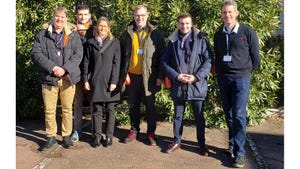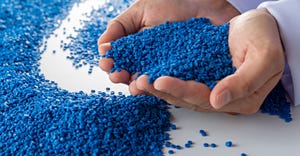Small Erie molder makes big impact on healthcare recycling
American hospitals generate more than 400,000 tons of plastic and other packaging waste every year, and the percentage recycled is close to zero.
June 29, 2012

American hospitals generate more than 400,000 tons of plastic and other packaging waste every year, and the percentage recycled is close to zero.
Kurt Duska is leading technical efforts in a powerhouse recycling coalition. |
That's about to change, in part because of a chance conversation an Erie, PA injection molder had on an airplane with a medical manufacturer. "She told me she wished more of the products they made could be recycled," Kurt Duska, president of Engineered Plastics Inc. and EPI Recycling Solutions said in an interview with PlasticsToday.
Two years ago Duska joined with officials from Beckton, Dickinson and Co.; Cardinal Health; DuPont; Hospira, Johnson & Johnson; Kimberley Clark; and Waste Management to form the Healthcare Plastics Recycling Council. Since the formal launch of HPRC in 2010, six other companies have joined the effort: Eastman Chemical, Covidien, SABIC, Phillips Healthcare, Kimberly-Clark, and Baxter International.
Cleveland Clinic pilot study
The group's goal is to promote recycling of plastics and other materials used in the healthcare field. Duska was the pilot study lead for one of the group's first big accomplishments: an evaluation of recyclability and best practices of pre-patient operating room waste.
The pilot study, conducted with the Cleveland Clinic and Waste Management, indicated that operating room plastics can be economically recycled with less environmental impact than an equivalent amount of virgin plastics. Design guidelines were developed from the study listing suggested do's and don'ts.
Practices to be avoided include:
Use of rubber seals on polypropylene saline bottles;
Combination of incompatible bioplastics and oil-based plastics in one product;
Welding, gluing, or insert molding of two components of unlike plastics in the same part. One example is a polycarbonate handle with an overmolded silicone grip;
Paper indicator tape on sterilization wrap; and
Paper and film combinations used in packaging.
The design guidelines promote use of monomaterial structures, chemically compatible materials (e.g., polyolefins) in single devices, and use of breathable plastics as alternatives to paper, such as spunbound polypropylene and nonwoven high density polyethylene (HDPE). The guidelines also suggest minimal use of pigments in healthcare products. Pigments, particularly dark colors, limit re-use options of recycled plastics.
Tyvek may have big role
In one example of a potential change, labels made from a polyolefin fiber called Tyvek made by DuPont would replace paper labels on polyolefin bags, making them easier to recycle. The Tyvek label could be
One of the project's goals is to eliminate packages that use paper and plastics. |
recycled with the bag. Tyvek is already used extensively in healthcare applications, and DuPont is studying possible use of Tyvek regrind in other medical applications.
"A lot of the changes that can be made are simple things," says Duska. "For example, a one-liter polypropylene irrigation bottle has a paper label. If we can switch that to a PP label, it dramatically improves the potential to recycle that product." Soda bottles have already gone through a similar design transformation to materials that can be recycled together.
EPI Recycling has worked with faculty and students at the Penn State Behrend campus in Erie to study specific hospital waste such as blue sterilization wrap with and without paper tape to see what the specific value of the waste stream is each way. The work is supported by a $500,000 grant from the Pennsylvania Department of Environmental Protection.
Partners in that project are Waste Management and the UPMC (University of Pittsburgh Medical Center). EPI Recycling does not collect waste from hospitals. Its function is to process and prepare the material for re-use.
Land of the giants
It's interesting that such a small operation like Duska's could fit in well with the giants on the HPRC.
"We work on niche, specific recycling programs for hospitals that a lot of big companies wouldn't bother with," says Duska. "There's a need for involvement of some smaller companies that don't mind getting their hands dirty. We climb right into the garbage."
The goal of the HPRC program is to develop designs that have little if any cost impact while increasing the potential for recycling. Many major healthcare groups and their suppliers already have sustainability programs that have to date stressed energy and water savings. Recycling is the next frontier. The focus of the HPRC is on materials that do not come into contact with the patient.
Duska's enthusiasm and leadership in the technical aspects of the HPRC are interesting since his companies seem to have less skin in the game that the resin and medical device powerhouses involved.
"What we're doing now will increase the opportunity for profitable recycling from hospitals in two to three years
Duska's companies are developing expertise in converting trash into pellets that can be used in high-tech molding processes. |
when these design changes start to take effect," says Duska. "We can make changes today that will help the environment and give us a profitable stream. I'm doing this to make my life easier."
The long-term goal of the project is to re-use medical waste in medical packaging, but the immediate goal is to find a profitable re-use for the material. One example could be use in recycling containers located in hospitals.
"We're not going after every material," says Duska. "We're targeted on products and processes that are clean, safe and have the best opportunity for producing at least a cost-neutral situation for hospitals." The focus is on polyethylene, polypropylene, polyethylene terephthalate glycol, and polystyrene.
Important leverage
Another important point is that involvement with the HPRC gives EPI Recycling some leverage.
"If I went to a label company and said it would be a good idea to change materials, they wouldn't take me seriously," says Duska. "But when I walk in with Johnson & Johnson and Baxter, I get a lot of attention. In our group, we have close to $500 billion in sales. A lot of these companies are competitors, but they are working together to make changes that will improve cost structures for hospitals and dramatically decrease the amount of good plastic into the landfill."
There is a fit between Duska's recycling business and his injection molding company, which he and two partners founded in 1986.
"We got into recycling because our customers were looking for low-cost feedstocks. Now we're processing a million pounds a month of recycled plastic at our Erie facility, focusing on polyolefins and polystyrene and doing a lot of work with the food industry." EPI recently opened a second recycling facility in Sanford, NC. The $1 million investment includes an NGR Recycling System which will be delivered in October.
There are 31 injection molding machines up to 850 tons in clamping force in the processing side of the business called Engineered Plastics, and one of the specialties, not surprisingly, is working with recycled compounds. "We've been molding these materials for 30 years now. If a company wants to use recycled material, I will run the trials for their specific requirements."
The molding angle
Duska has run recycled pellets on a sophisticated Husky machine molding thin-wall containers on very tight cycles. That's a different game than shoveling recycled pellets into a 25-year-old machine with poor tolerance control to make patio chairs. Engineered Plastics added a 210-ton Nissei two-shot machine to its lineup last year.
Investment this year is focused on the recycling side of the business, which is mostly post-industrial.
Duska's story is an interesting illustration of how even small players can have very big impacts. And big things can happen for very small reasons. "That chance conversation on an airplane changed my career," says Duska.
You May Also Like


